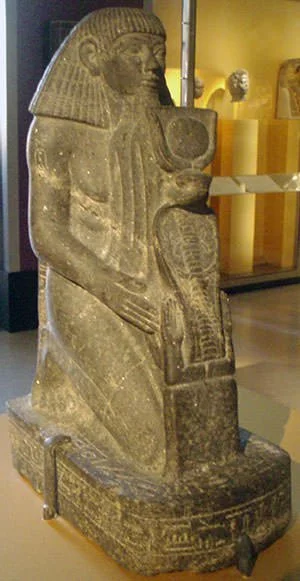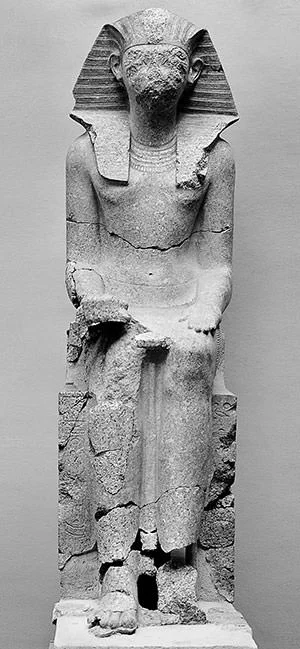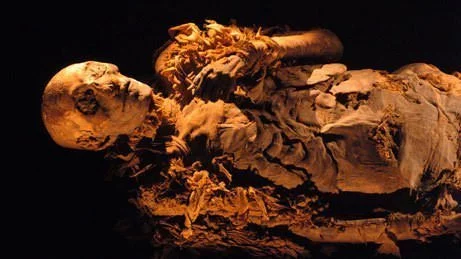Hatshepsut was an ancient Egyptian pharaoh who is one of the most famous female figures from antiquity. She is the second confirmed female pharaoh and the longest reigning female pharaoh of an indigenous dynasty of ancient Egypt. There has been lot of research and literature on Hatshepsut. Many points about her are still debated. Among these are: why did she become the de facto ruler of Egypt when she was initially acting as regent on behalf of her stepson Thutmose III; why did she order herself to be depicted as male; and why did Thutmose III try to erase her from history. Know about all this and more through these 10 interesting facts on Hatshepsut, the famous female pharaoh of ancient Egypt.
Note: This post was originally published on Sep 16, 2014.
#1 The theory that she usurped the throne is now mostly rejected
After the death of her husband Thutmose II, Hatshepsut was made regent till her young stepson, Thutmose III, came of age. This was in keeping with the traditions in ancient Egypt. However, by the seventh year of her reign, Hatshepsut was recognized as the pharaoh and not the queen. Though there are a few exceptions, it was very rare for a female to assume the duties of the pharaoh. Hatshepsut was the de facto ruler of ancient Egypt for around 20 years. This makes her the longest reigning female pharaoh from an indigenous dynasty of ancient Egypt. Early Egyptologists believed that she was a usurper who played devious politics to assume and maintain power. However, it is now believed that this was not the case. Perhaps a political crisis, like a threat from a competing branch of the royal family, led to Hatshepsut declaring herself as pharaoh. Once she assumed power, the God-like attributes associated with a pharaoh in ancient Egypt, might have made it difficult for her to step down.
Main Source:-
B. Wilson, Elizabeth. (2006). “The Queen Who Would Be King”. Smithsonian Magazine.

#2 She was not the first female pharaoh
There were several queens of ancient Egypt who ruled as at least regents before Hatshepsut. Neithhotep of the Early Dynastic Period (c. 3150 BCE – c. 2613 BCE) may have ruled alone. Merneith is another woman from the same period who might have ruled on her own right. Queen Sobeknefru (c. 1807-1802 BCE), the last monarch of the 12th Dynasty of Egypt, is the first attested female pharaoh of Egypt. The New Kingdom of Egypt (1550 BCE – 1070 BCE), saw a number of women in positions of power. Hatshepsut is the most famous among them. She is the second historically confirmed female pharaoh after Sobeknefru.
Main Sources:-
Mark, Joshua J. (2017). “Great Female Rulers of Ancient Egypt”. World History Encyclopedia.
Hill, J (2018). “Sobekneferu”. Ancient Egypt Online.

#3 Hatshepsut is depicted in statues as a male
Due to her sex, Hatshepsut must have known that her legitimacy as a pharaoh was weak. Probably for this reason, she reinvented herself. She took on the a new name, Maatkare, which roughly translates to “Truth is the Soul of the Sun God”. Maat was an ancient Egyptian expression for order and justice as established by the gods. By taking such a name, Hatshepsut was reassuring her subjects that she was a legitimate ruler who could speak with the Gods. Apart from the name, statues were created depicting her as a male king, with bulging muscles and the traditional pharaonic false beard. However, “the names that she used as king were formed with grammatically feminine participles, thus openly acknowledging her female status”. Moreover, several existing statues also portray her in typically feminine attire. The male appearance may thus be just a way to reemphasize her right to rule as a pharaoh.
Main Sources:-
B. Wilson, Elizabeth. (2006). “The Queen Who Would Be King”. Smithsonian Magazine.
Jarus, Owen. (2018). “Hatshepsut: Powerful Female Pharaoh”. Live Science.

#4 She was perhaps the world’s first arborist
One of the major achievements of Hatshepsut was the expedition she sent to the Land of Punt which brought back many riches. Among these were live trees, specifically myrrh and frankincense. Root protectors were used to carefully place 31 trees in the ships. On reaching Egypt, the trees were planted in the courts of her mortuary temple complex. Murals celebrating the expedition give testimony to this. Hatshepsut may thus be regarded as the world’s first arborist as she led a successful attempt at transplanting foreign fauna. An arborist is a person who studies the cultivation and management of individual trees.
Main Source:-
Zobeir Ali, Charlotte. (2020). “Hatshepsut, the 5th Pharaoh of the 18th Dynasty and the World First Arborist”. Medium.
#5 Senenmut was most probably not her lover
Senenmutwas a close advisor of Hatshepsut. Among other things, he was the principal person responsible for all the major building projects during Hatshepsut’s reign. He was also tutor to Hatshepsut’s only child, Neferure. Senenmut was of humble origins and his unusual rise to prominence has led to much speculation about a possible romantic relationship between him and Hatshepsut. Early Egyptologists believed that Senenmut was indeed her lover and aided her in her rise to power. However, little evidence exists to support this claim and it has now been rejected by most modern scholars.
Main Sources:-
“Senenmut”. The Rosicrucian Egyptian Museum.
(2019). “Hatshepsut”. HISTORY.

#6 Her successors attempted to erase her from Egyptian history
Hatshepsut died around 1458 BCE. She was succeeded by Thutmose III, her stepson who was the official co-ruler during her reign. After her death, Thutmose III, and then his son Amenhotep II, systematically removed her image from monuments, reliefs, statues, cartouches and the official list of Egyptian rulers. It was earlier assumed that Thutmose hated her stepmother and this was an act of vengeance. This theory is now mostly disregarded as Hatshepsut raised Thutmose as her successor instead of killing him. Moreover, he was the head of the army, a position given to him by Hatshepsut; but he never attempted to overthrow his stepmother.
Main Source:-
Bond, Sarah E. (2011). “Erasing the Face of History”. The New York Times.

#7 There is debate about why Thutmose III tried to erase her from history
The reason behind undermining her legacy is still not known with certainty and there are several theories regarding this, some of which are as follows. Thutmose III might have wanted to maintain the line of royal succession from Thutmose II to himself. Maybe, he wanted to claim her achievements and incorporate her reign into his own. Or perhaps, as Hatshepsut was a very successful pharaoh, he wanted to “prevent the possibility of another powerful female ever inserting herself into the long line of Egyptian male kings.”
Main Sources:-
B. Wilson, Elizabeth. (2006). “The Queen Who Would Be King”. Smithsonian Magazine.
Tyldesley, Joyce. (2011). “Hatshepsut and Tuthmosis: a royal feud?”. BBC.
#8 Her reign was rediscovered in 1822
Construction of a tomb for Hatshepsut had begun when she was the Great Royal Wife of Thutmose II. However upon ascending the throne, preparation for a new burial site started that would suit a Pharaoh. The tomb of her father, which is now referred to as KV20, was extended with a new chamber. Most probably, upon her death Hatshepsut was buried along with her father Thutmose I in KV20. Due to the efforts of her successors, Hatshepsut’s groundbreaking reign remained a secret for centuries. When archaeologists began deciphering the hieroglyphics at Deir el Bahri in 1822, and later found her tomb in 1903, the accomplishments of her reign as perhaps the most powerful female pharaoh became known.
Main Sources:-
Rattini, Kristin Baird. (2019). “Who was Hatshepsut?”. National Geographic.
Forbes, Dennis C. (2005). “Maatkare Hatshepsut: The Female Pharaoh”. pp. 26–42.

#9 Her mummy was found in 2007 with the help of a tooth
In 1881, a canopic box was found which was inscribed with Hatshepsut’s name. Along with an embalmed liver and stomach, it contained a tooth. In 1903, British archaeologist Howard Carter discovered the KV60 tomb inside which mummies of two women were found. One was identified as Hatshepsut’s wet nurse Sitre-In while the other remained unidentified. In 2007, Dr. Zahi Hawass, Egypt’s chief archaeologist, tested the unidentified body. It was found that the mummy had a missing tooth and the tooth from Hatshepsut’s box matched exactly with the missing upper molar of the mummy. Her mummy was probably moved from KV20 to KV60 by Thutmose III. According to Dr. Zahi Hawass, “the discovery of the Hatshepsut mummy is one of the most important finds in the history of Egypt”.
Main Source:-
Pilkington, Ed & Tran, Mark. (2007). “Tooth solves Hatshepsut mummy mystery”. The Guardian.

#10 Hatshepsut might have died due to her medicine
Among the possessions of Hatshepsut was a bottle which didn’t hold a perfume but a kind of skin care lotion. On examining it, it was found to that it was used to fight a persistent itch. This evidence is supported by the fact that there were cases of skin disease in Hatshepsut’s family. The bottle contained benzo(a)pyrene, “one of the most dangerous carcinogenic substances we know”. It is thus believed that Hatshepsut suffered from a chronic skin disease and applied a carcinogenic skin lotion for short term improvement. This exposed her to great risks over the years. It is known that Hatshepsut might have died from cancer and, if this was the case, then the ingredients of her skin lotion could have been the cause of it.
Main Source:-
(2011). “Deadly ancient Egyptian medication? German scientists shed light on dark secret of Queen Hatshepsut’s flacon”. ScienceDaily.


i need the citation information please!
Rawat, Anirudh. May 31, 2021. “Hatshepsut | 10 Facts About The Female Pharaoh of Egypt”. Learnodo Newtonic. Turiya Infotainment Private Limited.
Hope that helps.
hi i am using this site for a writing project and need to know when your last update as of dec 7 2020
plz get back to me as soon as possible my project is due tomorrow
The post was last updated on September 16, 2014. The site was last updated on December 7, 2020. Hope that helps.
thanks my dude i used this for my social studies project and the slide i used your facts in was highlighted with a smiley face 😀 I got an A
You’re welcome. We are glad to help you with your project.